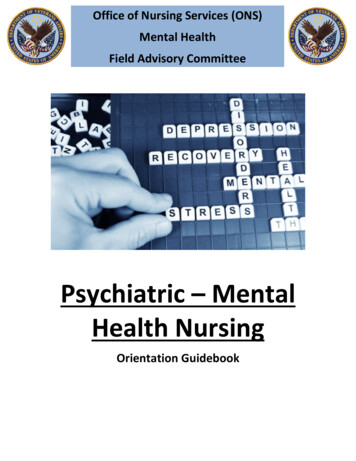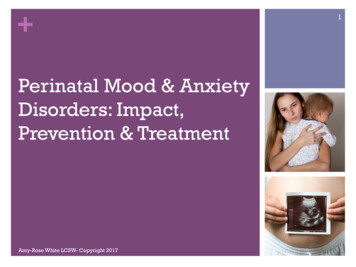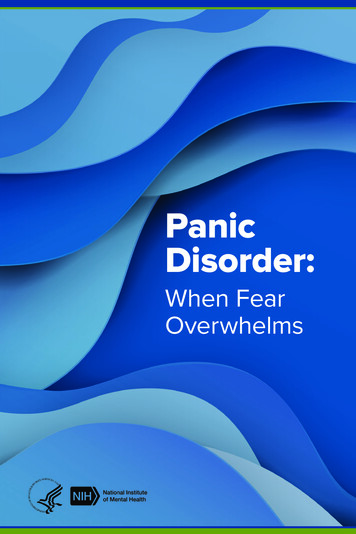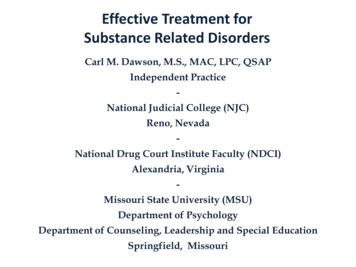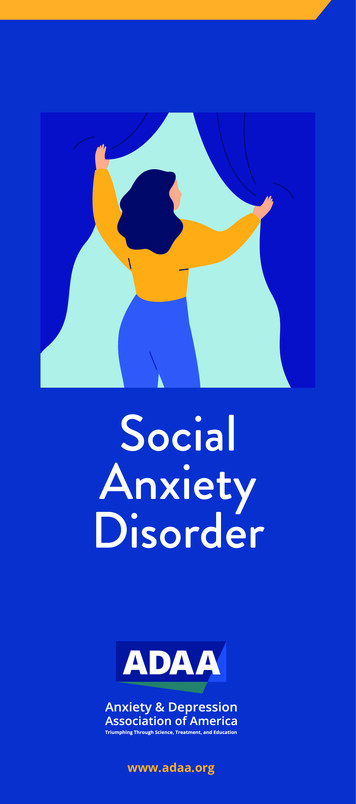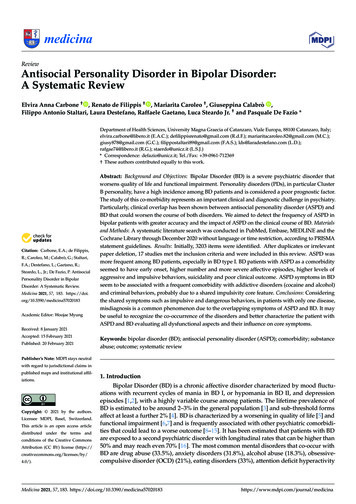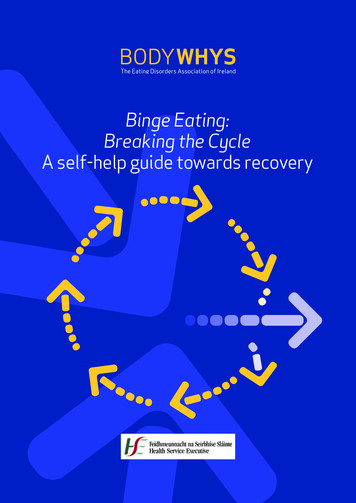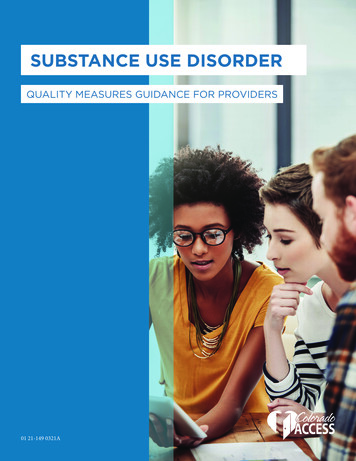
Transcription
SUBSTANCE USE DISORDERQUALITY MEASURES GUIDANCE FOR PROVIDERS01 21-149 0321A
MEASURE 1The organizational leadership demonstrates a commitment to quality treatment ofsubstance use disorders (SUD).STANDARDThe organizational mission, vision, and policies demonstrate a clear commitment to SUDas health conditions that develop both independently and in conjunction with othermental health and physical health conditions. The organization’s clinical leadership iscredentialed in SUD treatment and has the expertise necessary to meet the needs ofpatients, payers, community, and other key constituents. The organization has a clearlyidentified supervision structure that uses data to shape clinical supervision, clinical policy,and programming decisions.SPECIFIC CRITERIA Organizational chart shows clear oversight for substance use services from clinical/medical leadership. Clinical/medical leadership is credentialed in substance use treatment. Medical director is available in residential and withdrawal management levels of care. Organizational mission, vision, and policies demonstrate clear commitment totreatment of SUD. Supervisory structure is well-defined. Clinical supervision is provided to include supervision for staff members who lackcredentialing to provide independent SUD counseling under their scope of practice. Organization uses data to structure and improve clinical care.Resources:1. American Society of Addiction Medicine. (2020) ASAM Level of Care Certification Manual2. Medical Economics. (2015). Building a medical group in 12 roup-12-steps3. Society for Human Resources Management (SHRM). (2015). Understanding Organizational anizationalculture.aspx4. Substance Abuse and Mental Health Services Administration. (2021). The Substance Use Disorder CounselingCompetency Framework: An Overview. 017
MEASURE 2The organization and its programs have clear operational definitions.STANDARDThe organization has clear operational definitions that accurately delineate the typeand levels of care offered and include admission, discharge, and continuing stay criteriafor each program and level of care within each program. Residential and withdrawalmanagement programs have clearly-articulated exclusion criteria. The operationaldefinitions include the philosophy or approach to SUD service delivery, descriptions ofhow assessments and level of care determinations are established, the range of servicesdelivered within the program or service level, and the staff credentials and responsibilities.SPECIFIC CRITERIA Each program and level of care within the program is completely described in policyor program description, and the description aligns with the American Society ofAddiction Medicine (ASAM) level of care descriptions. Admission, discharge, and continuing stay criteria are all appropriate to the level ofcare and population served. Medical and other exclusion criteria are clear and appropriate to level of care andpopulation served. Services described and service approaches are complete and specific to the needs ofpatients with SUD, individualized to the needs of the population served, and plannedto respond to individual patient needs. Staffing is appropriate to the level of care provided.Resources:1. American Society of Addiction Medicine. (2020) ASAM Level of Care Certification Manual2. American Society of Addiction Medicine. (2013). The ASAM Criteria: Treatment Criteria for Addictive, SubstanceRelated, and Co-Occurring Conditions (M. David Mee-Lee Ed. 3rd ed.). Rockville, MD.3. Substance Abuse and Mental Health Services Administration. (2020). Substance Use Disorder Treatment for Peoplewith Co-Occurring Disorders. (PEP20-02-01-004). ncbi.nlm.nih.gov/books/NBK64197/
MEASURE 3Clinically integrated provider trainings are regularly provided to staff members.STANDARDStaff members are trained on SUD-specific content, including the organization’s SUDtreatment philosophy and approach, evidence-based practices in use in the organization,laws and ethical guidelines specific to the populations served, and levels of care provided.Training and case consultation are provided both at hire and periodically thereafter.SPECIFIC CRITERIA Training plans include content specific to SUD clinical practice. Training is tailored to the populations and levels of care provided. Training is ongoing.Resources:1. American Society of Addiction Medicine. (2020) ASAM Level of Care Certification Manual2. Substance Abuse and Mental Health Services Administration. (2021). The Substance Use Disorder CounselingCompetency Framework: An Overview. 017
MEASURE 4Treatment approaches used are based on current evidence of clinical effectiveness.STANDARDClinical protocols are based on best practices, including those identified by the AmericanSociety of Addiction Medicine (ASAM), National Institute on Drug Abuse (NIDA),Substance Abuse and Mental Health Services Administration (SAMHSA) and communitystandards. The provider is trained on and uses evidence-based practices (EBP) that arespecific to the needs of the populations served and the level or levels of care provided.In addition to participating in training in the EBPs in use, providers have proceduresto ensure that the practice is implemented correctly and adaptations are done withconsideration for the impact on the effectiveness. Emerging clinical practices that donot have strong evidence of effectiveness are reviewed with additional scrutiny andhave justification for implementation based on the level of care, community setting, andpopulation served.SPECIFIC CRITERIA Policies and/or program descriptions describe the evidence-based and best practicesin use in each level of care that are specific to the needs of the population and level ofcare. Staff members are trained and supervised to ensure that EBPs are fully implementedwith fidelity.Resources:1. NIDA principles of effective treatment: nciples-effective-treatment2. U.S. Department of Health and Human Services (HHS) Office of the Surgeon General. (2016). Facing Addiction inAmerica: The Surgeon General’s Report on Alcohol, Drugs, and Health. Washington DC: HHS.addiction.surgeongeneral.gov/
MEASURE 5The provider implements procedures to continually assess and adjust treatment planningand level of care.STANDARDProviders are knowledgeable of American Society of Addiction Medicine (ASAM) level ofcare criteria and have procedures to assess patients initially and continually throughouttreatment across the six dimensions outlined in ASAM.SPECIFIC CRITERIA Initial assessment addresses six dimensions outlined in ASAM and includesstandardized screening/assessment as appropriate to level of care. Initial assessment supports the level of care provided. Admission, discharge, and transfer policies are aligned with ASAM level ofcare criteria. Procedures are in place to continually assess patients for treatment needs andplacement appropriateness. Staff members are assigned to continually assess the patient in between formaltreatment plan reviews. ASAM dimensions are used to determine ongoing treatment needs at time ofdischarge/transfer.Resources:1. American Society of Addiction Medicine. (2020) ASAM Level of Care Certification Manual2. American Society of Addiction Medicine. (2013). The ASAM Criteria: Treatment Criteria for Addictive, SubstanceRelated, and Co-Occurring Conditions (M. David Mee-Lee Ed. 3rd ed.). Rockville, MD.3. U.S. Department of Health and Human Services (HHS) Office of the Surgeon General. (2016). Facing Addiction inAmerica: The Surgeon General’s Report on Alcohol, Drugs, and Health. Washington DC: HHS.addiction.surgeongeneral.gov/
MEASURE 6Substance use monitoring (urine screening, oral fluid tests, breathalyzers) is a standardpart of substance use treatment at all levels of care.STANDARDMonitoring drug or alcohol use is an important disincentive for continued use andtherefore is incorporated as a standard practice at all levels of care. Drug or alcohol testingis used to support recovery, rather than as a punishment, and positive drug or alcohol teststrigger a discussion with the patient about alterations of the treatment plan.SPECIFIC CRITERIA Program materials articulate the clinical rationale for monitoring as a componentof treatment. Programs/providers that share monitoring information with criminal justice or childwelfare agencies clearly describe the distinction between their use in treatment andtheir use to determine legal sanctions.Resources:1. American Society of Addiction Medicine. (2020) ASAM Level of Care Certification Manual2. NIDA principles of effective treatment: nciples-effective-treatment
MEASURE 7Relapse is not a criterion for discharge and is considered a part of the recovery process.STANDARDThe reoccurrence of symptoms, or relapse, is viewed as a need to readjust treatmentrather than a reason to discontinue treatment. When patients relapse, or continue touse substances, clinical staff members, in conjunction with the patient, re-examine thetreatment plan, including the level of care.SPECIFIC CRITERIA Policies do not support discharge or exclude people from admission due torelapse history. The reaction to relapse is therapeutic rather than punitive. Patient materials communicate that relapse, or continued use, is an indicator of theneed to change treatment level or treatment plan.Resources:1. American Society of Addiction Medicine. (2013). The ASAM Criteria: Treatment Criteria for Addictive, SubstanceRelated, and Co-Occurring Conditions (M. David Mee-Lee Ed. 3rd ed.). Rockville, MD.2. NIDA principles of effective treatment: nciples-effective-treatment3. Substance Abuse and Mental Health Services Administration. (2019). Enhancing Motivation for Change in SubstanceUse Disorder Treatment. TIP 35: EP19-02-01-003
MEASURE 8Patients are actively encouraged to become involved in social and recovery supportactivities tailored to their individual needs and preference.STANDARDSocial support is one of the most powerful predictors of ongoing recovery. Effectiveprograms communicate to patients that recovery happens in life, rather than in treatmentand that the non-clinical elements are essential to set people up for lasting recovery.High-quality providers address recovery support needs such as building supportive socialrelationships, healthy recreational activities, and safe housing. This includes encouragingparticipation in self-help groups or other mutual aid groups and using recovery coaches orpeer specialists as a part of the treatment team.SPECIFIC CRITERIA Patient materials and program policies emphasize the importance of social andrecovery support. Building peer and recovery support is an integral part of the treatment, discharge,and relapse planning process. Service planning includes recovery environment considerations such as safe,drug-free housing. Providers actively assist patients in identifying and selecting social support activitiesbased on their needs and preferences. Providers use peer specialists and recovery coaches to assist with engagement inservices and transitions in care.Resources:1. American Society of Addiction Medicine. (2020) ASAM Level of Care Certification Manual2. American Society of Addiction Medicine. (2013). The ASAM Criteria: Treatment Criteria for Addictive, SubstanceRelated, and Co-Occurring Conditions (M. David Mee-Lee Ed. 3rd ed.). Rockville, MD.3. NIDA principles of effective treatment: nciples-effective-treatment4. U.S. Department of Health and Human Services (HHS) Office of the Surgeon General. (2016). Facing Addiction inAmerica: The Surgeon General’s Report on Alcohol, Drugs, and Health. Washington DC: HHS.addiction.surgeongeneral.gov/5. U.S. Department of Veterans Affairs. (2020). Management of Substance Use Disorders. VA/DoD Clinical PracticeGuidelines. healthquality.va.gov/guidelines/MH/sud/
MEASURE 9Individual counseling is a standard part of treatment.STANDARDThe mix of therapeutic interventions should be determined following an assessmentof the strengths and needs of the patient and the patient’s preferences. Althoughgroup treatment can be a powerful therapeutic tool for many people, for some peoplerequirements to participate in group treatment may discourage participation in anytreatment. Sensitive issues of abuse, trauma, guilt and shame may be more effectivelyaddressed in individual sessions or be more effectively addressed in group sessionsafter individual counseling. High-quality treatment programs will hold regular individualcounseling sessions as a standard course of treatment to discuss treatment progress andcheck in on sensitive issues that may not be effectively addressed in group treatment.SPECIFIC CRITERIA Individual counseling is scheduled on regular intervals. Participation in group treatment is not a requirement of receiving treatment. Treatment approaches are individualized to the needs and preferences of the patient. Staff members are skilled in motivational approaches to counseling and use theseskills to explore resistance to participating in group treatment. Programs treating patients that satisfy drinking and driving requirements makerecommendations about the mix of services based on individual needs, rather thanjust what is needed to satisfy legal requirements.Resources:1. Lo Coco, G., et. Al., (2019). Group treatment for substance use disorder in adults: A systematic review and meta-analysisof randomized-controlled trials. Journal of Substance Abuse Treatment, 99, 104-116. doi: doi.org/10.1016/j.jsat.2019.01.0162. NIDA principles of effective treatment: nciples-effective-treatment3. Substance Abuse and Mental Health Services Administration. (2021). Group Therapy in Substance Use Treatment.Advisory. se-treatment/pep20-02-01-0204. U.S. Department of Health and Human Services (HHS) Office of the Surgeon General. (2016). Facing Addiction inAmerica: The Surgeon General’s Report on Alcohol, Drugs, and Health. Washington DC: HHS.addiction.surgeongeneral.gov/
MEASURE 10The initial contact is predominately a clinical intervention rather than an administrativeintake exercise.STANDARDProviders design the initial contacts with patients or potential patients with the goal ofbuilding a therapeutic alliance and motivating follow-up action. High-quality providerstrain all staff members who encounter patients in motivational interviewing and otherengagement strategies to enhance the likelihood that the individual will seek care.Assessment and data collection are integrated into the clinical intervention and spreadover time in order to address the patient’s presenting problems and provide immediateassistance with attaining their goals related to the presenting problems. High-qualityproviders help patients access the services that will best meet their needs, even whenthese services fall outside the treatment program’s capabilities.SPECIFIC CRITERIA Patient-facing staff members are educated about substance use and addiction,trained in motivational interviewing, and given the tools needed to respond topatients in a non-judgmental manner. Administrative and intake paperwork are spread throughout initial sessions. Procedures are in place to reduce resistance to treatment and actively encouragepatients to continue care. Patients who are determined to be inappropriate for care at a particular level of careor provider are actively assisted in finding a provider who is appropriate to providethe needed care.Resources:1. NIDA principles of effective treatment: nciples-effective-treatment2. Substance Abuse and Mental Health Services Administration. (2019). Enhancing Motivation for Change in SubstanceUse Disorder Treatment TIP35. EP19-02-01-0033. U.S. Department of Health and Human Services (HHS) Office of the Surgeon General. (2016). Facing Addiction inAmerica: The Surgeon General’s Report on Alcohol, Drugs, and Health. Washington DC: HHS.addiction.surgeongeneral.gov/
MEASURE 11Family and other support systems are routinely involved in treatment.STANDARDIndividuals with substance use disorders often have damaged family relationships, andrebuilding these relationships can assist the patient in sustaining recovery. High-qualityprograms emphasize the importance of involving family and other support systems incounseling in order to strengthen the supportive environment and reduce risk for relapse.SPECIFIC CRITERIA Treatment at Level 3-residential and 2.1-intensive outpatient routinely includesevidence-based family interventions. Treatment of adolescents routinely involves evidence-based family interventions. Family is defined broadly based on the patient’s support system. Relapse prevention planning addresses risk and resiliency factors associatedwith family interactions.Resources:1. American Society of Addiction Medicine. (2020) ASAM Level of Care Certification Manual2. NIDA principles of effective treatment: nciples-effective-treatment3. Substance Abuse and Mental Health Services Administration. (2021). The Importance of Family Therapy in SubstanceUse Disorder Treatment. Advisory. -substance-use-disordertreatment/pep20-02-02-0164. Substance Abuse and Mental Health Services Administration. (2020). Substance Use Disorder Treatment and FamilyTherapy TIP 39. amily-therapy/PEP20-02-02-012
MEASURE 12Providers have procedures to complete follow-up calls on all patient no-shows andthese procedures include working with patients on motivational and tangible barriersto care.STANDARDHigh-quality providers have systems in place to contact a patient who misses a scheduledappointment or admission in order to assist the patient in overcoming tangible andmotivational barriers. High-quality providers approach follow-up on “no-shows” assupportive interventions rather than instituting punitive policies.SPECIFIC CRITERIA Follow-up is completed routinely on missed appointments or admissions. Staff members conducting follow-up contacts are trained in strategies to enhancemotivation and provided with the resources to assist the patient with motivational andtangible barriers. No-shows are not punished, but instead, patients with patterns of no-shows areprovided with additional support such as navigation programs or drop-inappointment hours.Resources:1. American Society of Addiction Medicine. (2013). The ASAM Criteria: Treatment Criteria for Addictive, SubstanceRelated, and Co-Occurring Conditions (M. David Mee-Lee Ed. 3rd ed.). Rockville, MD.2. NIDA principles of effective treatment: nciples-effective-treatment3. Substance Abuse and Mental Health Services Administration. (2019). Enhancing Motivation for Change in SubstanceUse Disorder Treatment. TIP 35. EP19-02-01-0034. U.S. Department of Health and Human Services (HHS) Office of the Surgeon General. (2016). Facing Addiction inAmerica: The Surgeon General’s Report on Alcohol, Drugs, and Health. Washington DC: HHS.addiction.surgeongeneral.gov/5. U.S. Department of Veterans Affairs. (2020). Management of Substance Use Disorders. VA/DoD Clinical PracticeGuidelines. healthquality.va.gov/guidelines/MH/sud/
MEASURE 13Providers accept patients who are currently receiving medications for treatment ofaddiction and do not discourage the use of medication for treatment of alcohol and opioiduse disorders.STANDARDHigh-quality programs, regardless of treatment philosophy or level of care, do notdiscourage the use of FDA-approved medications for the treatment of opioid and alcoholuse disorders and educate patients on their potential value in treatment. Programsproviding medication assisted treatment encourage patients to participate in counselingand support activities in conjunction with medication.SPECIFIC CRITERIA Programs that do not administer medication for treatment of addiction have protocolsto educate patients who may benefit from medications on their availability and referto providers who can prescribe medications as appropriate. Programs do not have criteria that exclude people from admission due to current useof medication assisted treatment (MAT) for addiction. Residential and inpatient programs have formal relationships with providerscredentialed to dispense methadone when patients currently on methadone are inresidential treatment. Programs treating pregnant women are knowledgeable of and adhere to currentmedical and clinical best practices related to use of medications to treat addiction inpregnant women.Resources:1. American Society of Addiction Medicine. (2020) ASAM Level of Care Certification Manual2. NIDA principles of effective treatment: nciples-effective-treatment3. Substance Abuse and Mental Health Services Administration. (2021). Prescribing Pharmacotherapies for Patients withAlcohol Use Disorder. Advisory. -0154. Substance Abuse and Mental Health Services Administration. Medications for Opioid Use Disorder. TreatmentImprovement Protocol (TIP) Series 63, Executive Summary. Publication No. PEP20-02-01-005. Rockville, MD: SubstanceAbuse and Mental Health Services Administration, 2020. 5. Substance Abuse and Mental Health Services Administration. (2019). Medications to Treat Opioid Use Disorder DuringPregnancy. s/SMA19-5094-IS6. U.S. Department of Health and Human Services (HHS) Office of the Surgeon General. (2016). Facing Addiction inAmerica: The Surgeon General’s Report on Alcohol, Drugs, and Health. Washington DC: HHS.addiction.surgeongeneral.gov/
MEASURE 14All providers treating SUD are capable to screen for mental health conditions and providea basic level of mental health treatment.STANDARDBecause nearly one-third of all people with substance use disorders also have a mentalhealth disorder, quality providers have the capability to screen for mental health disordersand provide or refer for medication evaluation and mental health treatment. High-qualityproviders accept individuals with mild or moderate mental health disorders in theirprograms and have staff members who are capable to provide care. Programs supportpatients to continue medications that have been prescribed for mental health treatment.SPECIFIC CRITERIA Admission criteria do not exclude people with mild or stable mental health disorders. Providers, at a minimum, have staff members capable to screen and refer for mentalhealth disorders. Providers educate patients about the interaction of mental health and substance usesymptoms on relapse potential. Providers facilitate continuation of mental health medications during treatment.Resources:1. American Society of Addiction Medicine. (2020) ASAM Level of Care Certification Manual2. American Society of Addiction Medicine. (2013). The ASAM Criteria: Treatment Criteria for Addictive, SubstanceRelated, and Co-Occurring Conditions (M. David Mee-Lee Ed. 3rd ed.). Rockville, MD.3. NIDA principles of effective treatment: nciples-effective-treatment4. Substance Abuse and Mental Health Services Administration. (2020). Substance Use Disorder Treatment for Peoplewith Co-Occurring Disorders. (PEP20-02-01-004). ncbi.nlm.nih.gov/books/NBK64197/
MEASURE 15Providers continually assess patients’ treatment needs, tailor length of stay to individualneeds, and provide coordinated transitions between levels of care.STANDARDThe level of care needs of the patient are assessed regularly, at highest frequency atthe higher levels of care. The level of care and treatment plan is modified based on thetreatment response, progress in treatment, and outcomes. Providers do not promote afixed length of stay to either the patient or the community. High-quality programs educatepatients and potential patients that treatment length in a particular level of care variesbased on their needs and that continuing in treatment following high intensity treatmentis important for sustained recovery. Programs ensure a smooth transition betweenlevels of care and have procedures to ensure warm hand-offs to care both outside theirorganization and within levels of care in their own organization.SPECIFIC CRITERIA Programs are described to staff members, patients, and the community as variablelength of stay based on the patient’s changing needs. Procedures are in place to continually assess level of care needs and transfer smoothlyto a lower or higher level of care as needed.Resources:1. American Society of Addiction Medicine. (2020) ASAM Level of Care Certification Manual2. American Society of Addiction Medicine. (2013). The ASAM Criteria: Treatment Criteria for Addictive, SubstanceRelated, and Co-Occurring Conditions (M. David Mee-Lee Ed. 3rd ed.). Rockville, MD.3. NIDA principles of effective treatment: nciples-effective-treatment4. U.S. Department of Health and Human Services (HHS) Office of the Surgeon General. (2016). Facing Addiction inAmerica: The Surgeon General’s Report on Alcohol, Drugs, and Health. Washington DC: HHS.addiction.surgeongeneral.gov/5. U.S. Department of Veterans Affairs. (2020). Management of Substance Use Disorders. VA/DoD Clinical PracticeGuidelines. healthquality.va.gov/guidelines/MH/sud/
MEASURE 16Emergency services are available to active patients.STANDARDHigh-quality providers offer after-hours emergency services to address treatment-relatedissues that arise. The primary goal of these services is to stabilize symptoms of distressand to engage patients in an appropriate treatment service or modify the treatment planto address the problem that led to the crisis. Residential and withdrawal managementprograms have access to consultation with a medical provider.SPECIFIC CRITERIA Procedures are in place to communicate with patients about how to reach a clinicianin the event of a crisis. Procedures are in place to communicate across the treatment team after acrisis occurs. Level 3 residential and withdrawal management programs have access to medicalconsultation after-hours.Resources:1. American Society of Addiction Medicine. (2020) ASAM Level of Care Certification Manual2. American Society of Addiction Medicine. (2013). The ASAM Criteria: Treatment Criteria for Addictive, SubstanceRelated, and Co-Occurring Conditions (M. David Mee-Lee Ed. 3rd ed.). Rockville, MD.
MEASURE 17Programs employ strategies to provide easy access to treatment.STANDARDPatients with substance use disorders rarely make the decision to enter treatment duringnormal business hours. In addition, many patients have a responsibility to care for familyor maintain employment that interferes with their ability to attend regular business hourappointments. High-quality treatment programs have easy access to services and minimizebarriers to access both initial and ongoing care.SPECIFIC CRITERIA Facilities, marketing materials, and websites include instructions that are linguistically,developmentally, and culturally appropriate for the population served. Initial and ongoing appointments are available outside business hours. Procedures and policies to access treatment do not impose unnecessary barriers.Resources:1. NIDA principles of effective treatment: nciples-effective-treatment2. U.S. Department of Health and Human Services (HHS) Office of the Surgeon General. (2016). Facing Addiction inAmerica: The Surgeon General’s Report on Alcohol, Drugs, and Health. Washington DC: HHS.addiction.surgeongeneral.gov/
MEASURE 18Programs screen and refer for infectious diseases that commonly co-occur with substanceuse disorders.STANDARDPatients with drug use disorders (in particular, IV drug use), are at high risk for HIV/AIDS,tuberculosis and hepatitis B and C. High-quality providers have protocols to screen, test,and refer for treatment as appropriate.SPECIFIC CRITERIA Screening routinely occurs with patients who are
2. American Society of Addiction Medicine. (2013). The ASAM Criteria: Treatment Criteria for Addictive, Substance-Related, and Co-Occurring Conditions (M. David Mee-Lee Ed. 3rd ed.). Rockville, MD. 3. Substance Abuse and Mental Health Services Administration. (2020). Substance Use Disorder Treatment for People with Co-Occurring Disorders.
